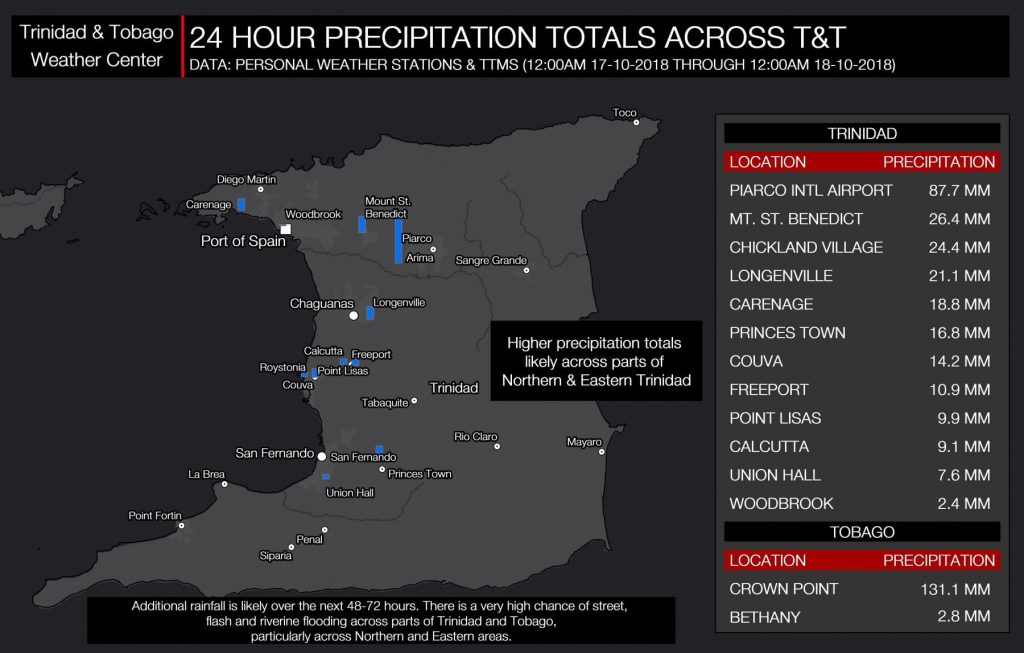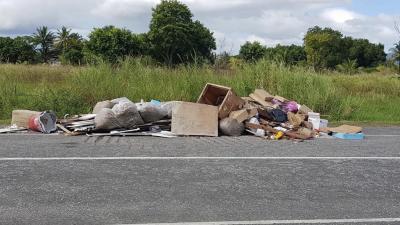Flooding occurs across various areas of Trinidad and Tobago for several reasons, usually a combination of both natural and artificial causes.
Natural Causes
Intense/Heavy Rainfall
During heavy or intense rainfall, as large drops hit the ground with force, drops may bounce off the ground instead of being absorbed by the soil. Rainwater runs off across the surface, increasing the runoff and water levels in watercourses. Intense or heavy rainfall can occur anytime throughout the year, but these events typically occur during the Wet Season, where conditions for intense convective activity are favorable.
Prolonged Rainfall

Trinidad and Tobago typically has the highest threat of prolonged rainfall during the Wet Season, where the Inter-Tropical Convergence Zone, or tropical systems, can cause multi-day rain events. After several hours to several days of precipitation, soils become saturated. At this point, the land cannot hold any additional water, and rain becomes surface runoff. This runoff will raise already swollen watercourses and trigger flash flooding and/or riverine flooding.
Relief and Topography
Relief is the difference in height between the lowest and highest point on land. Surface runoff can move quickly down steep slopes and into low-lying areas in mountainous or hilly areas. The low-lying areas in Trinidad and Tobago, such as much of Northwestern Trinidad and the East-West corridor, south of the Northern Range, typically experience flash floods as streams and rivers become overwhelmed with surface runoff during a heavy rainfall event.
Human Causes
Deforestation

An aerial shot provided by Fishermen and Friends of the Sea shows an area cleared to make way for the new Manzanilla highway near the southern boundary of the Aripo Savannah.
Deforestation is the removal of a forest or forested area, where the land is then converted for non-forest use. Clearing trees and brush reduces the volume of water soils can absorb and retain. This leads to increased surface runoff, leading to increased flow into watercourses.
Note that wild or bush fires, where the forest and surrounding vegetation are burnt, can be considered natural or man-made causes depending on the ignition source. It has a similar effect to deforestation on the land.
Poor Land Use Practices
Across Trinidad and Tobago, slash and burn agriculture, over-cultivation, and over-grazing reduces the viability of the soil for vegetative growth. This leads to a result similar to deforestation, where the volume of water the soils can absorb and retain is reduced, and the surface runoff is increased.
Urbanization
Development across Trinidad and Tobago occurred at a rapid pace over the last several decades. This urbanization of already flood-prone areas led to replacing permeable soil with an impervious layer of asphalt and concrete – both impervious surfaces. This leads to pluvial flooding, which encompasses street/urban flooding and flash flooding due to increased surface runoff.
Improper Waste Disposal

Waste that has been improperly disposed of, such as dumping in or around watercourses or simply littering, ultimately finds its way into drains, streams, and rivers during rainfall, blocking or impeding water flow. This obstruction causes water to back up or overflow watercourses and lead to flooding. This is the most preventable cause of flooding across Trinidad and Tobago.
Quarrying
Quarrying is the process of removing rock, sand, gravel, or any other minerals from the ground to use them to produce materials for construction or other uses. Quarrying leads to deforestation and leaves the land unable to support vegetative growth. This increases surface runoff and leads to flooding.





